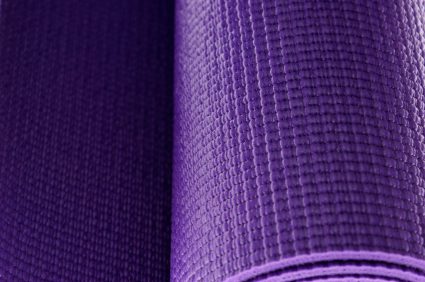How to choose the best yoga mat
Looking to buy a yoga mat? If you think the only considerations are its colour and design, think again. Not all yoga mats are created equal. Here’s how to make the best decision

Source: Web exclusive, November 2010
When it comes to buying the best yoga mat, there are more variables to consider than first meet the eye. Your first and most important choice might be to seek out either an eco yoga mat’made of natural materials’versus what’s most commonly available on the market.
"Most mats are made of PVC, latex, plastic or rubber," says Hema Murty, PhD, owner of Shanti Consulting, a fitness consulting company in Ottawa that offers one-on-one and group personal training and yoga instruction. However, some of these materials may be toxic to the people who use them. "Eco-friendly mats do not emit toxins," says Murty, whose background in yoga includes intensive yoga training in India.
Buying an eco yoga mat
Most yoga mats don’t come with labels, so how do you know what a yoga mat is made of? To check if a particular brand meets the criteria of an eco yoga mat, look for eco credentials’such as being PVC-free and made from a natural plant-based material like rubber or jute’on the yoga mat’s packaging or website.
You can also browse for yoga mats in a small yoga studio or yoga specialty shop, where employees might know more about what qualifies as an eco yoga mat compared to a larger store with a wide variety of general merchandise. (Heads up: eco yoga mats may also be pricier.)
Thick yoga mats and other comfort features
Once you’ve zeroed in on a yoga mat made of materials you’re happy with, your next consideration is comfort, such as the yoga mat’s thickness. In particular, says Murty, test out yoga mats that provide enough cushioning for the knees and wrists.
"A standard yoga mat is 3.2 millimetres thick," says Murty. "When choosing a yoga mat, look at the dimensions of the mat’the thickness tells you if it is a standard mat or a thicker mat for more cushioning. If the participant has issues with wrists, knees or ankles, then a thicker mat is preferable."
But is a thick yoga mat always the best choice? No. Thicker mats have more cushioning, Murty says, but they may also prevent smooth movement between asanas (i.e., yoga poses), such as in a Hatha yoga practice that flows through a series of sun salutations.
However, new yoga mat technology may solve this problem. "New yoga mats are now coming out that are thick for cushioning and also provide a smooth surface for flowing motion," says Murty.
While most mats are 172 centimetres long, Murty says you can get longer ones, ideal if you’re tall and prefer the extra mat space. Just remember, longer and thicker yoga mats might be more difficult to pack up and shove into a standard yoga mat carrier after class. "Thicker mats are more difficult to roll up and are heavier to carry," says Murty.
Testing out yoga mats
In addition to checking a yoga mat’s cushioning and traction and how it feels underfoot, consider that some styles of yoga, such as Bikram yoga, also dictate what type of yoga mat is most safe and effective. "Hot yoga entails a lot of sweating," says Murty. "Therefore, cotton yoga rugs are generally used in place of the latex mats."
Once you buy a yoga mat, the next test is to see if it’s a good fit for you. Sometimes that’s a matter of trial and error since not all yoga mat materials have the same "feel."
The final say on yoga mats
Trial and error is the best way to find the best yoga mat for your preferences, but it can be an expensive proposition. Prefer not to overinvest? Ask your yoga teacher and classmates for their recommendations, and to try out their yoga mats. Then buy a new yoga mat secure in the knowledge that you’re making an educated choice.
What kind of yoga mat do you prefer? Share your picks in the comments.




